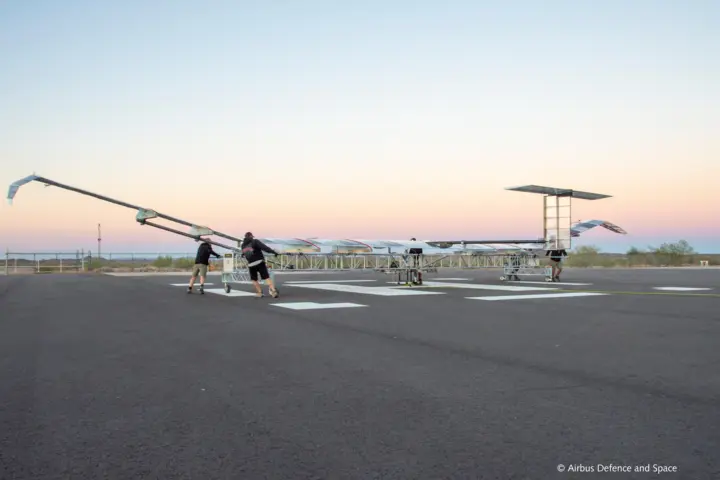Small and lightweight sensor design with full precision
Zephyr is an ultra-light weight, solar-electric HAPS with a wingspan of 25 meters and a weight of less than 75 kg. Powered by solar energy, it serves as a persistent platform – expected to stay for months at a height of 70,000 feet where pressure and temperature are more akin to space than ground conditions. Zephyr's developments go through state-of-the-art testing procedures to validate its safe operation in the stratosphere. For ground and flight testing purposes, Airbus relies on accelerometers from Kistler with small and light-weight measuring chains.
While ground testing ensures functionality and quality standards to approve sub-system design prior to flight, flight testing enables the acquisition of in-flight data to validate operational top-level requirements.
"We are using Kistler accelerometers and data acquisition equipment on ground testing of our propulsion systems for requirements validation. During flight we are using a slightly different Kistler instrument for dynamic data acquisition as part of our flight test instrumentation system."
Diogo Sousa, Lead Propulsion Engineer for Airbus Zephyr
Full operational functionality confirmed after extreme cold storage
Both solutions are based on an 8793A K-Shear accelerometer from Kistler. The low-temperature version of this triaxial IEPE sensor for shock and vibration measurement can be operated at down to –195°C, making it an ideal solution for flight tests in the extreme cold of the stratosphere. Nevertheless, there was a challenge to overcome, as Sharon Turner, Applications Engineer at Kistler explains: “The Zephyr team wanted to be able to turn off the sensor in flight in order to save battery power. Although the sensor will operate happily down at –196°C the minimum storage temperature we'd ever tested it to was only –75°C – we'd never anticipated anyone would want to power back up at –195°C. Also, we had no in-house capability to test below –150°C. So, we carefully worked through the design with our colleagues in the US and concluded that we were confident it should power back up and work perfectly, but we just couldn't prove it. So Airbus went ahead with their cryogenic trials and the unit did indeed work perfectly with no detrimental effect on performance.”
The measuring chain for Zephyr is completed by a custom cable solution from Kistler and for the ground test a laboratory charge amplifier, the 5165A LabAmp. This versatile high-end signal conditioning and data acquisition solution comes with either one or four channels and can be operated with many different sensor types – not just Kistler products. Sousa again: “We have been successfully using Kistler instruments for data acquisition on both flight and ground testing. The Zephyr team seeks a continuous development of Airbus' world-leading fixed-wing HAPS platform. For such, mean data acquisition and analysis is paramount to validate new disruptive designs and technologies.” The programming for LabAmp can be done comfortably on a browser window, and for higher channel numbers multiple devices can be daisy-chained including synchronization via PTP (Precision Time Protocol). “Apart from the flexible interface, we are also very satisfied with the measuring accuracy and the service from Kistler. What's more, the small and lightweight sensor design is key for the flight equipment,” Sousa explains.
Moving forward together with High Altitude Platform Stations
How is Airbus Zephyr going to develop in the near future and which goals lie ahead? According to Simon Taylor, Head of Zephyr Programme, the main focus is on further flight campaigns and customer collaboration in order to increase maturity and operational readiness. He comments: “Through working with Kistler we achieve two fundamental things which are key to Zephyr success: precision and mass minimization. By continuing to develop our technology based on high quality data we get closer and closer to system maturity and operational reality.”
However, there is an important non-technical aspect to be taken into account: stratospheric flight is rather new and therefore, regulations are being defined, with some initial principals requiring further elaboration; it requires strategic collaboration and development for effective common operational procedures. That is why Airbus is an executive member of the HAPS Alliance which unites companies from telecommunications, technology, aviation and aerospace in order to promote and democratize HAPS in the stratosphere. Important milestones include regulations, frequencies allocation, common standards and interoperability – and not least raising the global awareness of benefits that HAPS technology can bring to mankind.







![High above the clouds [object Object]](https://kistler.cdn.celum.cloud/SAPCommerce_Document_Preview/961-518e.webp)